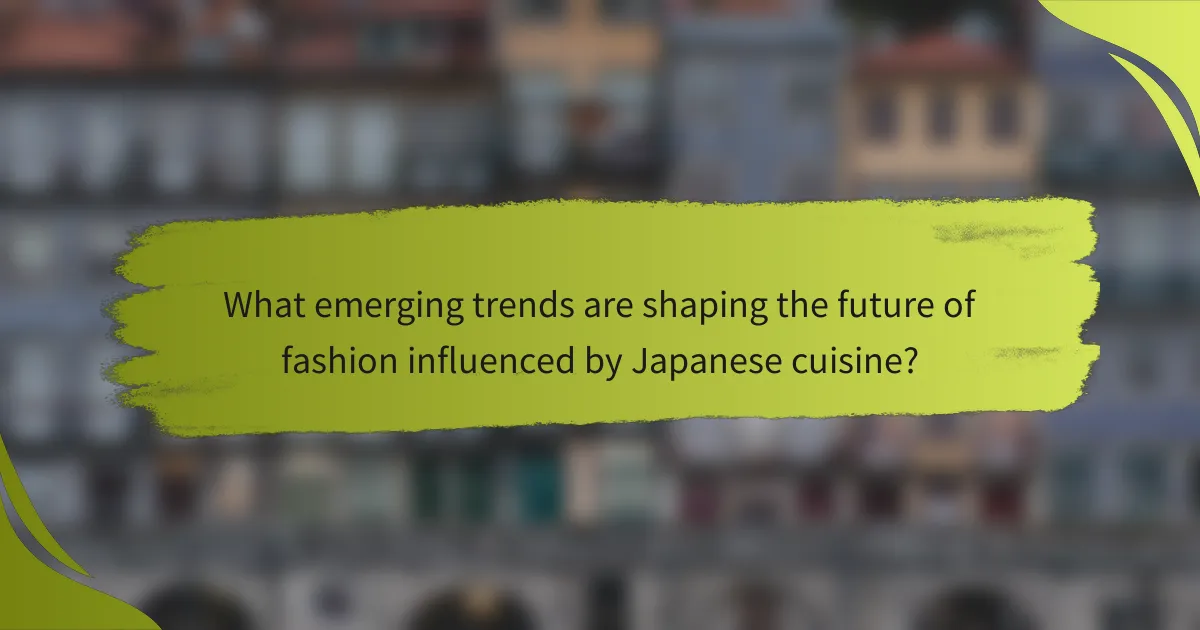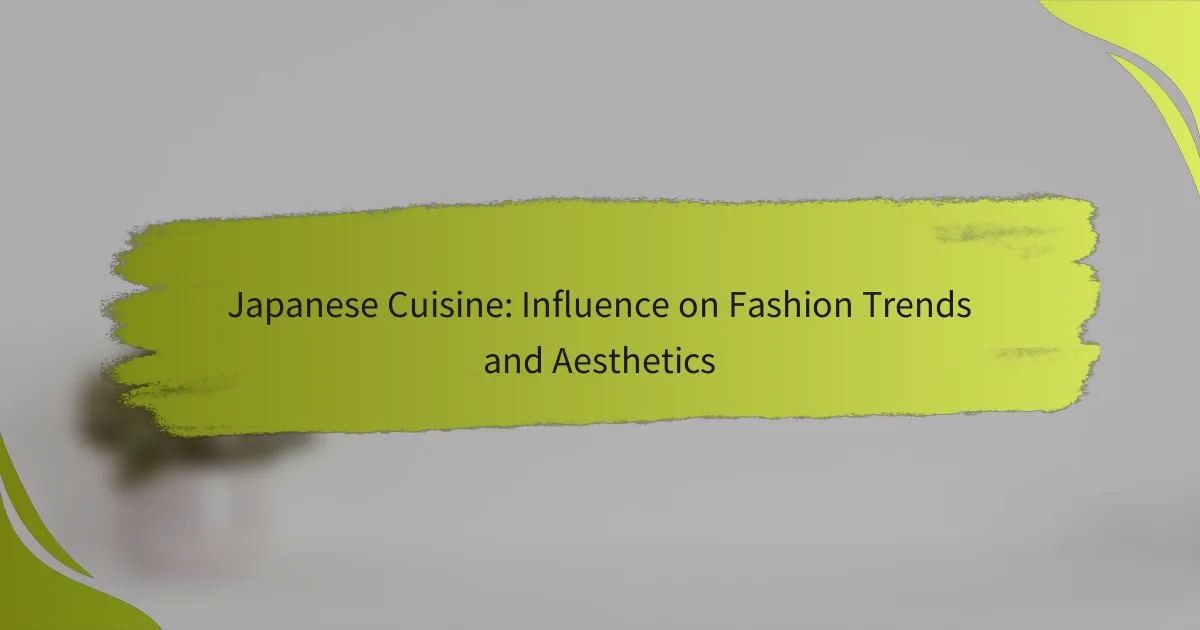日本の料理は、東京のファッショントレンドに大きな影響を与え、デザインやカラーパレット、全体的な美学にインスピレーションを与えています。料理とファッションの相互作用は、地元の人々や訪問者に共鳴する独自の文化表現を生み出します。

How does Japanese cuisine influence fashion trends in Tokyo?
Japanese cuisine significantly influences fashion trends in Tokyo by inspiring designs, color palettes, and overall aesthetics. The interplay between culinary elements and fashion creates a unique cultural expression that resonates with both locals and visitors.
Fusion of traditional and modern styles
The fusion of traditional Japanese cuisine with modern fashion trends is evident in various collections. Designers often draw inspiration from traditional garments, such as kimonos, and incorporate motifs or patterns reminiscent of food items, like sushi or seasonal dishes. This blend creates a fresh take on classic styles, appealing to a younger audience.
For example, a contemporary streetwear brand might use fabrics that mimic the textures of rice or seaweed, merging culinary artistry with wearable fashion. This approach not only honors Japan’s rich culinary heritage but also keeps the designs relevant in today’s fast-paced fashion landscape.
Impact of seasonal ingredients on color palettes
Seasonal ingredients in Japanese cuisine play a crucial role in shaping color palettes within fashion. Designers often reflect the vibrant hues found in seasonal dishes, such as the deep reds of autumn persimmons or the soft greens of spring bamboo shoots. These colors are frequently seen in collections released during specific seasons, creating a visual connection between food and fashion.
For instance, a spring collection might feature pastel shades inspired by sakura (cherry blossoms), mirroring the fleeting beauty of seasonal ingredients. This practice not only enhances the aesthetic appeal but also promotes an appreciation for the changing seasons in both cuisine and clothing.
Celebrity endorsements of Japanese culinary aesthetics
Celebrity endorsements have a powerful impact on the intersection of Japanese culinary aesthetics and fashion trends. Influential figures often showcase their love for Japanese cuisine through their clothing choices, promoting brands that incorporate food-inspired designs. This visibility can lead to increased interest in both the cuisine and the fashion associated with it.
For example, a popular musician might wear a jacket featuring prints of traditional Japanese dishes during a public appearance, sparking trends among fans and fashion enthusiasts. Such endorsements help to elevate the status of Japanese culinary aesthetics within the fashion industry, encouraging a broader audience to explore this unique cultural blend.

What are the key aesthetic elements derived from Japanese cuisine?
Japanese cuisine significantly influences fashion trends and aesthetics through its emphasis on simplicity, natural beauty, and harmony. Key aesthetic elements include minimalism, natural color palettes inspired by ingredients, and textural contrasts that reflect the presentation of food.
Minimalism in design
Minimalism is a core principle in both Japanese cuisine and design, emphasizing simplicity and functionality. This aesthetic encourages clean lines, uncluttered spaces, and a focus on essential elements, allowing the beauty of each item to shine. In fashion, this translates to streamlined silhouettes and understated elegance.
To incorporate minimalism, choose clothing with simple cuts and neutral colors. Avoid excessive embellishments and focus on high-quality materials that enhance the overall look without overwhelming it.
Natural color schemes inspired by ingredients
Natural color schemes in Japanese cuisine draw inspiration from the ingredients used, reflecting the seasons and local produce. Earthy tones, soft pastels, and vibrant colors from fresh vegetables and fruits create a palette that is both soothing and visually appealing. This approach can be mirrored in fashion through the selection of colors that evoke the beauty of nature.
When selecting outfits, consider colors that reflect the seasons, such as muted greens in spring or warm oranges in autumn. This not only creates a cohesive look but also connects the wearer to the natural world.
Textural contrasts reflecting food presentation
Textural contrasts are vital in Japanese cuisine, where the presentation of food often showcases a variety of textures, from smooth to crunchy. This principle can be applied to fashion by mixing different fabrics and materials to create visual interest. Combining textures adds depth and complexity to an outfit.
For example, pairing a soft silk blouse with structured denim or a knitted sweater with leather pants can create a dynamic look. Aim for a balance of textures to enhance the overall aesthetic without overwhelming the viewer.

How do culinary events shape fashion in Japan?
Culinary events significantly influence fashion trends in Japan by merging gastronomy with design aesthetics. These events create a unique platform where food-inspired themes inspire collections, leading to innovative collaborations between chefs and fashion designers.
Fashion shows featuring food-inspired collections
Fashion shows in Japan often incorporate food themes, showcasing collections that draw inspiration from culinary elements. Designers may use colors, textures, and patterns reminiscent of traditional Japanese dishes, such as sushi or ramen, to create visually striking garments.
For instance, a collection might feature fabrics that mimic the appearance of food items or prints that represent seasonal ingredients. This approach not only captivates audiences but also celebrates Japan’s rich culinary heritage.
Pop-up dining experiences influencing designer collaborations
Pop-up dining events serve as a creative intersection for chefs and fashion designers, leading to unique collaborations. These experiences often feature exclusive menus that reflect the aesthetic of a designer’s collection, creating a multisensory experience for attendees.
For example, a designer might host a pop-up dinner where each course is inspired by their latest collection, allowing guests to experience the fusion of food and fashion firsthand. This trend enhances brand visibility and fosters a deeper connection between culinary art and fashion aesthetics.

What role do cultural festivals play in merging cuisine and fashion?
Cultural festivals serve as vibrant platforms where Japanese cuisine and fashion intersect, showcasing the rich heritage of both. These events highlight traditional attire while also introducing contemporary fashion influenced by culinary elements.
Seasonal festivals showcasing traditional attire
Seasonal festivals in Japan, such as Hanami and Tanabata, prominently feature traditional garments like kimonos and yukatas. During these events, attendees often dress in elaborate outfits that reflect seasonal themes, enhancing the visual appeal of the festival.
The combination of traditional attire with local culinary specialties creates a unique atmosphere, where food and fashion complement each other. For example, at a summer festival, the vibrant colors of yukatas may mirror the bright hues of seasonal dishes like yakitori and kakigori.
Food stalls influencing streetwear trends
Food stalls at festivals not only offer delicious treats but also inspire streetwear trends among younger generations. The aesthetics of food packaging, vibrant colors, and playful designs often translate into fashion items, such as graphic tees and accessories.
For instance, popular festival snacks like takoyaki and taiyaki can lead to clothing lines featuring prints or motifs inspired by these foods. This fusion of culinary art and fashion creates a dynamic cultural exchange that resonates with both locals and tourists.

How can brands leverage Japanese culinary aesthetics in their collections?
Brands can effectively leverage Japanese culinary aesthetics by integrating visual elements inspired by traditional dishes and presentation styles into their fashion collections. This approach not only enhances the visual appeal but also creates a cultural connection that resonates with consumers.
Incorporating food motifs in fabric designs
Using food motifs in fabric designs can create a unique identity for a fashion line. Patterns inspired by sushi, ramen, or seasonal ingredients can be printed on textiles, offering a playful yet sophisticated aesthetic. Brands should consider using colors and textures that reflect the essence of Japanese cuisine, such as the earthy tones of matcha or the vibrant hues of seasonal vegetables.
When selecting motifs, it’s crucial to maintain authenticity and respect for the culture. Collaborating with local artists or designers who understand the nuances of Japanese culinary art can enhance the integrity of the designs.
Collaborations with Japanese chefs for exclusive lines
Partnering with renowned Japanese chefs can elevate a fashion brand’s profile and create exclusive lines that celebrate culinary artistry. These collaborations can result in limited-edition pieces that reflect the chef’s signature style or philosophy, making them highly desirable to consumers. For instance, a chef might inspire a collection based on their favorite ingredients or traditional cooking techniques.
Brands should ensure that these collaborations are marketed effectively, highlighting the chef’s influence and the story behind the collection. This not only adds value but also engages consumers who appreciate the fusion of food and fashion.

What are the prerequisites for understanding this cultural intersection?
To grasp the influence of Japanese cuisine on fashion trends and aesthetics, one must have a foundational knowledge of both Japanese culinary history and contemporary fashion movements. These elements intertwine, reflecting cultural values and societal shifts that shape both food and fashion.
Knowledge of Japanese culinary history
Understanding Japanese culinary history involves recognizing key elements such as traditional ingredients, cooking techniques, and regional variations. For instance, the use of seasonal ingredients and presentation styles like kaiseki not only define Japanese cuisine but also inspire fashion aesthetics that emphasize simplicity and elegance.
Moreover, historical events, such as the introduction of Western cuisine during the Meiji era, have led to hybrid styles that influence modern fashion. This blending of traditions can be seen in contemporary designs that incorporate motifs inspired by food, such as patterns resembling sushi or tea ceremonies.
Understanding of contemporary fashion movements
Contemporary fashion movements often reflect broader cultural trends, including sustainability and minimalism, which resonate with traditional Japanese values. Designers may draw inspiration from the aesthetics of Japanese cuisine, using color palettes and textures that evoke the visual appeal of food presentations.
Additionally, the rise of street fashion in Japan, characterized by its playful and eclectic styles, showcases how culinary influences can manifest in clothing. For example, garments featuring prints of popular Japanese dishes or food-related themes highlight the connection between what we wear and what we eat.

What emerging trends are shaping the future of fashion influenced by Japanese cuisine?
Emerging trends in fashion influenced by Japanese cuisine focus on sustainability, aesthetics, and cultural fusion. Designers are increasingly drawing inspiration from the visual and sensory aspects of Japanese food, leading to innovative styles that reflect these culinary influences.
Integration of sustainability in food and fashion
Sustainability is becoming a cornerstone in both the culinary and fashion industries, with a growing emphasis on eco-friendly practices. Fashion brands are adopting materials that reflect the principles of Japanese cuisine, such as using organic fabrics and natural dyes that echo the colors of traditional dishes.
For instance, brands may use indigo dye, reminiscent of traditional Japanese textiles, which is derived from natural sources and has a lower environmental impact. This integration not only promotes sustainability but also connects consumers to the cultural heritage of Japan.
Global fusion trends incorporating Japanese elements
Global fashion is increasingly embracing fusion trends that incorporate Japanese elements, blending them with various cultural aesthetics. This trend is evident in the use of traditional Japanese patterns, such as sakura (cherry blossom) motifs, combined with Western silhouettes, creating a unique and appealing style.
Designers are also experimenting with culinary-inspired designs, where garments mimic the textures and colors of Japanese dishes, such as the layering seen in sushi. This fusion not only broadens the appeal of fashion but also celebrates the rich cultural narratives behind Japanese cuisine.
